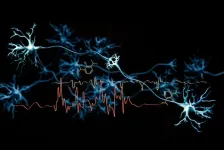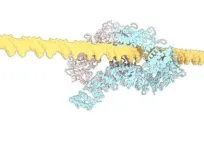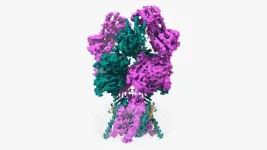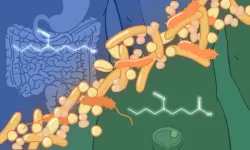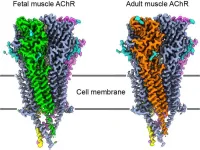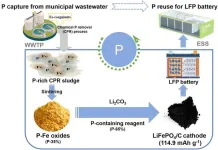(Press-News.org) The general anesthetic propofol may hold the keys to developing new treatment strategies for epilepsy and other neurological disorders, according to a study led by researchers at Weill Cornell Medicine and Sweden’s Linköping University.
In their study, published July 31 in Nature, the researchers determined the high-resolution structural details of how propofol inhibits the activity of HCN1, an ion channel protein found on many types of neurons. Drug developers consider inhibiting HCN1 a promising strategy for treating neurologic disorders including epilepsy and chronic pain. The researchers also found, to their surprise, that when HCN1 contains either of two epilepsy-associated mutations, propofol binds to it in a way that restores its functionality.
“We might be able to exploit propofol’s unique way of binding to HCN1 for the treatment of these drug-resistant epilepsies and other HCN1-linked disorders, either by directly repurposing propofol or by designing new, more selective drugs that have the same mechanism of action,” said study co-senior author Dr. Crina Nimigean, professor of physiology and biophysics in anesthesiology at Weill Cornell Medicine.
The other co-senior author was Dr. Peter Larsson, a professor in the department of biomedical and clinical sciences at Linköping University.
The study’s first author was Dr. Elizabeth Kim, a postdoctoral research associate in the Nimigean laboratory in the Department of Anesthesiology at Weill Cornell Medicine. Dr. Xiaoan Wu, a postdoctoral research associate in the Larsson Laboratory, was co-first author. The laboratories of Dr. Alessio Accardi and Dr. Peter Goldstein from Weill Cornell Medicine also contributed to this work.
HCN ion channels in humans come in four basic forms, HCN1 to HCN4, and are found especially on cells in the heart and nervous system. They work as switches to control the electrical voltage across the cell membrane, opening to admit an inward flow of positively charged potassium and sodium ions—thus “depolarizing” the cell—when the voltage reaches a certain threshold. This function underpins much of the rhythmic activity of brain and heart muscle cells, which is why HCN channels are also called pacemaker channels.
In the study, the researchers used cryo-electron microscopy and other methods to determine, at near-atomic scale, how propofol reduces HCN1 activity—which it does with selectivity for HCN1 over other HCNs. They found that the drug inhibits HCN1 by binding within a groove between two elements of the channel protein’s central pore structure, making it harder for the pore to open.
As they investigated propofol’s action on HCN1, the researchers examined how the drug affects different known mutants of the channel, including mutants that leave it excessively open and are associated with hard-to-treat epilepsy syndromes such as early infantile epileptic encephalopathy (EIEE). The researchers were surprised to find that for two different HCN1 mutations that cause EIEE, propofol restores the mutant channels to normal or near-normal function.
From their experiments, the researchers derived a model in which the mutations decouple HCN1’s voltage-sensing and pore mechanisms, while propofol effectively recouples them, allowing membrane voltage to control ion flow again.
The results suggest at least two possibilities for translation to therapies. One is simply to use propofol, an existing, approved drug, to treat these HCN1-mutation epilepsies and potentially other HCN1-linked disorders. Propofol is a potent anesthetic that requires careful monitoring by anesthesiologists, but it might be able to restore HCN1 function at doses below those used for general anesthesia.
The other possibility, the researchers said, is to use the new structural data on propofol’s binding to design modified, non-anesthetic versions of propofol, or even completely different compounds, that bind to HCN1 with a similar effect but much more selectively—in other words, without binding to other channels, including other HCNs, in the body and thereby potentially causing unwanted side effects.
“For that we will need a better understanding of how propofol inhibits HCN1 better than other HCN channels,” Dr. Kim said.
The work presented here was supported in part by the National Institute of General Medical Sciences and the National Institute of Neurological Disorders and Stroke, both part of the National Institutes of Health, through grant numbers GM124451, GM139164, GM128420, R42NS129370, NS137561 and GM145091. Additional support was provided by the Hartwell Foundation.
END
A new use for propofol in treating epilepsy?
2024-07-31
ELSE PRESS RELEASES FROM THIS DATE:
Trust in physicians and hospitals during the COVID-19 pandemic in a 50-state survey of US adults
2024-07-31
About The Study: The results of this survey study of U.S. adults suggest that trust in physicians and hospitals decreased during the COVID-19 pandemic. As lower levels of trust were associated with lesser likelihood of pursuing vaccination, restoring trust may represent a public health imperative.
Corresponding Author: To contact the corresponding author, Roy H. Perlis, MD, MSc, email rperlis@mgh.harvard.edu.
To access the embargoed study: Visit our For The Media website at this link https://media.jamanetwork.com/
(doi:10.1001/jamanetworkopen.2024.24984)
Editor’s ...
State policies regulating firearms and changes in firearm mortality
2024-07-31
About The Study: In this comparative effectiveness study of state firearm policies, the joint effect estimates of combinations of firearm laws were calculated, showing that restrictive firearm policies were associated with substantial reductions in firearm mortality. Although policymakers would benefit from knowing the effects of individual policies, the estimated changes in firearm mortality following implementation of individual policies were often small and uncertain.
Corresponding Author: To contact the corresponding ...
City-level sugar-sweetened beverage taxes and youth body mass index percentile
2024-07-31
About The Study: Sugar-sweetened beverage excise taxes were associated with lower body mass index percentile among youth in this cohort study. Policymakers should consider implementing sugar-sweetened beverage excise taxes to prevent or reduce youth overweight and obesity and, ultimately, chronic disease, particularly among children younger than 12 years.
Corresponding Author: To contact the corresponding author, Deborah Rohm Young, PhD, email deborah.r.young@kp.org.
To access the embargoed study: Visit our For The Media website at this link https://media.jamanetwork.com/
(doi:10.1001/jamanetworkopen.2024.24822)
Editor’s ...
Impact of neighborhood resources on resilience after trauma
2024-07-31
E. Kate Webb, PhD, a research fellow at McLean Hospital who works in the Neurobiology of Fear Laboratory and Neurobiology of Affective and Traumatic Experiences Laboratory, led an investigation into whether individual resources and neighborhood resources, like greenspace, might impact neurobiology and the trajectory of posttraumatic stress disorder (PTSD) symptoms. Her research was published July 31st in JAMA Psychiatry.
What led you to examine the link between neighborhood characteristics and PTSD?
About 46 million people experience ...
Study finds nearly half of top cancer centers required universal masking during last winter’s COVID-19 surge
2024-07-31
Nearly half of the nation’s National Cancer Institute (NCI)-designated cancer centers required universal masking in key clinical areas during the winter 2023-2024 COVID-19 surge, according to a study by Tulane University researchers.
Overall, 41.8% of these 67 centers required some universal masking, according to the study, which published in JAMA Network Open. Further, 12 NCI-designated centers (18%) required universal masking in all areas. Masking policies were even more common in northeastern states and in centers with longer NCI designation, more funding and higher care rankings.
Those with cancer face higher risks from COVID-19 ...
This protein does “The Twist”
2024-07-31
Proteins are constantly performing a kind of dance. They move and contort their bodies to fulfill specific functions inside our bodies. The NMDAR protein executes an especially hard dance routine in our brains. One wrong step can lead to a range of neurological disorders. NMDAR binds to the neurotransmitter, glutamate, and another compound, glycine. These bindings control NMDAR’s dance steps. When their routine is over, the NMDAR opens. This open ion channel generates electrical signals critical for cognitive functions like memory.
The problem is that scientists couldn’t figure out the last step in NMDAR’s routine—until ...
Gut microbes implicated in bladder cancer
2024-07-31
At any given time, over 10 trillion microbes call our guts their home. From breaking down nutrients in our food to strengthening our immunity against pathogens, these microbes play an essential role in how we interact with the world. This includes – as shown in a new study by EMBL researchers and collaborators at the University of Split, Croatia – the way the body responds to carcinogens and develops cancer.
Carcinogens are chemicals that can cause ordinary cells to transform into cancer ...
Trust in physicians and hospitals declined over the course of the COVID-19 pandemic
2024-07-31
BOSTON– A cross-representative survey of adults in the United States showed decreasing levels of trust in physicians and hospitals during the COVID-19 pandemic—and the lower the trust, the less likely an individual was to get vaccinated against SARS-CoV-2 or influenza. The findings come from a survey study of more than 400,000 U.S. adults published in JAMA Network Open by a team co-led by investigators at Massachusetts General Hospital (MGH), a founding member of the Mass General Brigham healthcare system.
“Trust in ...
Unraveling a key junction underlying muscle contraction
2024-07-31
The connections between the nervous system and muscles develop differently across the kingdom of life. It takes newborn humans roughly a year to develop the proper muscular systems that support the ability to walk, while cows can walk mere minutes after birth and run not long after.
University of California San Diego researchers, using powerful new visualization technologies, now have a clear picture of why these two scenarios develop so differently. The results offer new insight into understanding muscle contraction in humans that may help in developing future treatments for muscular diseases.
“In this study we set out to understand ...
New method recovers phosphorus from wastewater to power the future of lithium-iron phosphate batteries
2024-07-31
In a recent study published in Engineering, a research team from the Shenzhen Engineering Research Laboratory for Sludge and Food Waste Treatment and Resource Recovery has introduced a pioneering method to tackle the critical global issue of phosphorus (P) scarcity. Their innovative approach leverages municipal wastewater to produce phosphorus vital for the manufacture of lithium iron phosphate (LiFePO4) batteries, a key component in the rapidly growing electric vehicle market.
As the demand for LiFePO4 batteries ...
